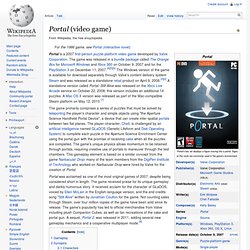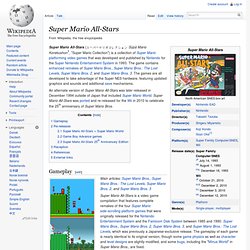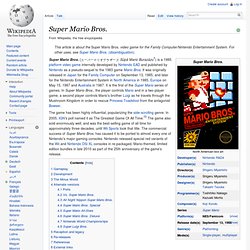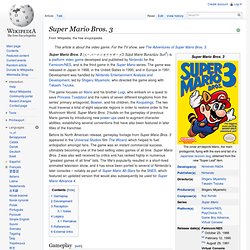

Portal (series) Portal (video game) Portal was acclaimed as one of the most original games of 2007, despite being considered short in length.

The game received praise for its unique gameplay and darkly humorous story. It received acclaim for the character of GLaDOS, voiced by Ellen McLain in the English-language version, and the end credits song "Still Alive" written by Jonathan Coulton for the game. Not counting sales through Steam, over four million copies of the game have been sold since its release.
The game's popularity has led to official merchandise from Valve including plush Companion Cubes, as well as fan recreations of the cake and portal gun. A sequel, Portal 2, was released in 2011, adding several new gameplay mechanics and a cooperative multiplayer mode.[8] A more advanced portal technique. Portal 2. Although some reviewers initially expressed concerns about the difficulty of expanding Portal into a full sequel, Portal 2 received universal acclaim upon its release, with the game's writing, pacing, and dark humor being highlighted as stand-out elements.

The voice work of McLain, Merchant, and Simmons were heavily applauded by critics, and the new gameplay elements, the game's challenging but surmountable learning curve, and the additional cooperative mode also received praise. Some gaming journalists ranked Portal 2 among the top games of 2011, and several named it their Game of the Year. Gameplay[edit] Portal 2 challenges players to use teleportation to traverse obstacle courses. The Binding of Isaac (video game) Castlevania: Aria of Sorrow. Castlevania: Aria of Sorrow, released in Japan as Castlevania: Akatsuki no Minuet (キャッスルヴァニア ~暁月の円舞曲~?)

, is a side-scrolling platforming video game developed and published by Konami for the Game Boy Advance. It is the third and final installment of the Castlevania series on the Game Boy Advance[2] and was released in North America on May 6, 2003 and released in Japan on May 8, 2003.[1] Producer Koji Igarashi, who led the production teams for previous Castlevania titles, led Aria of Sorrow's development.
Also returning is Michiru Yamane who, along with Takashi Yoshida and Soshiro Hokkai composed music for the game. New to the Casltevania series is Junichi Murakami who served as director. Aria of Sorrow is set in the year 2035, where Dracula has long been sealed away from a battle in 1999. Gameplay[edit] An image of gameplay, with the primary character, Soma Cruz, using a soul to attack a pair of enemies. Tactical Soul[edit] Donkey Kong. Titles outside these two genres have included rhythm games (Donkey Konga), racing games (Diddy Kong Racing), and edutainment (Donkey Kong Jr.

Math). A hallmark of the Donkey Kong series is barrels, which the Kongs use as weapons, vehicles, furniture and lodging. The Donkey Kong character is highly recognizable and very popular; the franchise has sold over 40 million units worldwide.[1] Synopsis[edit] Setting[edit] Characters[edit] Donkey Kong Country. Donkey Kong Country 2: Diddy's Kong Quest. Donkey Kong Country 2: Diddy's Kong Quest (abbreviated to DKC2) (スーパードンキーコング2 ディクシー&ディディー, Sūpā Donkī Kongu Tsū: Dikushī & Didī?

, Super Donkey Kong 2: Dixie & Diddy) is a 1995 adventure platform game developed for the Super Nintendo Entertainment System (otherwise known as the "SNES") produced by Rareware and published by Nintendo - with Diddy Kong and Dixie Kong starring as the main characters of the game. Donkey Kong Country 2 was first released on November 20, 1995 in North America. Donkey Kong Country 2 is a sequel to the original Donkey Kong Country (1994) which was later followed by Donkey Kong Country 3: Dixie Kong's Double Trouble! (1996). Super Mario All-Stars. An alternate version of Super Mario All-Stars was later released in December 1994 outside of Japan that included Super Mario World.

Super Mario Bros. The game has been highly influential, popularizing the side-scrolling genre.

In 2005, IGN's poll named it as The Greatest Game Of All Time.[5] The game also sold enormously well, and was the best-selling game of all time for approximately three decades, until Wii Sports took that title. The commercial success of Super Mario Bros. has caused it to be ported to almost every one of Nintendo's major gaming consoles.
Super Mario Bros. 3. Gameplay[edit] Super Mario Bros. 3 introduced several suits to alter the character's abilities.

For example, Mario can use the "Frog Suit" to swim more easily in water, but will move more slowly on land. The player navigates through the game via two game screens: an overworld map and a level playfield. The overworld map displays an overhead representation of the current world and has several paths leading from the world's entrance to a castle. Paths connect to action panels, fortresses and other map icons, and allow players to take different routes to reach the world's goal. Super Mario Bros. 3 featured a world map that would be seen again in future Mario titles. Super Mario Bros. 3 includes a multiplayer option which allows two players to cooperatively play the game by taking turns at navigating the overworld map and accessing stage levels; the first player controls Mario, while the other controls Luigi. Pokémon. Pokémon Red and Blue. Pokémon FireRed and LeafGreen. Pokémon FireRed Version and LeafGreen Version (ポケットモンスター ファイアレッド・リーフグリーン, Poketto Monsutā Faiareddo Rīfugurīn?

, lit. "Pocket Monsters: FireRed & LeafGreen") are enhanced remakes of the original Pokémon Red and Blue video games, which were released in 1996. Age of Mythology. Age of Mythology (AoM) is a mythology-based real-time strategy computer game developed by Ensemble Studios and published by Microsoft Game Studios.

It was released on October 30, 2002 in North America and a week later in Europe.[3] A spin-off from the Age of Empires series, Age of Mythology takes inspiration from the myths and legends of the Greeks, Egyptians, and Norse, rather than from actual history.[4] However, many gameplay elements are similar to the Age of Empires series. Its campaign follows an Atlantean admiral, Arkantos, who is forced to travel through the lands of the game's three cultures, hunting for a cyclops who is in league with Poseidon against Atlantis.[5] Age of Mythology was commercially successful, going platinum four months after its release after selling over one million units.[6] It also achieved critical acclaim, scoring 89% on both GameRankings and Metacritic.[7] On May 8, 2014, Age of Mythology: Extended Edition is set to be released on Steam for Windows.
The Elder Scrolls. The Elder Scrolls is a series of action role-playing open world fantasy video games primarily developed by Bethesda Game Studios and published by Bethesda Softworks. The series is known for their elaborate and richly-detailed open worlds and its focus on free-form gameplay. Morrowind, Oblivion and Skyrim all won multiple Game of the Year awards from various outlets. Development history[edit] Before The Elder Scrolls[edit] Prior to working on The Elder Scrolls series, Bethesda had worked predominately with sports and action games.
The Elder Scrolls IV: Oblivion. The Elder Scrolls IV: Oblivion is an action role-playing video game developed by Bethesda Game Studios and published by Bethesda Softworks and the Take-Two Interactive subsidiary 2K Games. It is the fourth installment in The Elder Scrolls action fantasy video game series, following The Elder Scrolls III: Morrowind and preceding The Elder Scrolls V: Skyrim. Oblivion was first released in March 2006 for Microsoft Windows and Xbox 360. A mobile phone version of the game was released in May 2006, and a PlayStation 3 version was shipped in March 2007. After a number of smaller content releases, a major expansion pack, Shivering Isles, was distributed. The Elder Scrolls V: Skyrim. The Elder Scrolls V: Skyrim is an action role-playing video game developed by Bethesda Game Studios and published by Bethesda Softworks. It is the fifth installment in The Elder Scrolls action role-playing video game series, following The Elder Scrolls IV: Oblivion. Skyrim was released on November 11, 2011, for Microsoft Windows, PlayStation 3 and Xbox 360.
Three downloadable content (DLC) add-ons were released—Dawnguard, Hearthfire and Dragonborn—which were repackaged into The Elder Scrolls V: Skyrim Legendary Edition, which released on June 4, 2013. Skyrim's main story revolves around the player character's efforts to defeat Alduin, a Dragon who is prophesied to destroy the world. Fallout 3. BioShock (series) BioShock. BioShock Infinite. Synopsis[edit] Star Wars: Battlefront II. Battlefront II was fairly well received, with the PlayStation 2 and Xbox versions scoring in the mid 80s at aggregators GameRankings and Metacritic. The PC version scored slightly lower at both sites, scoring a 76 at GameRankings and 78 at Metacritic. Halo (series) Halo: Combat Evolved. Halo has been praised as one of the best and most important video games of all time,[13][14] and was ranked by IGN as the fourth best first-person shooter of all time.[15] The game's popularity has led to labels such as "Halo clone" and "Halo killer," applied respectively to games either similar to or anticipated to be better than it.[16][17][18] In addition, the game inspired and was used in the fan-created Red vs.
Halo 2. After the success of Combat Evolved, a sequel was expected and highly anticipated. Bungie found inspiration in plot points and gameplay elements that had been left out of their first game, including multiplayer over the Internet through Xbox Live. Halo 3. Half-Life (series)